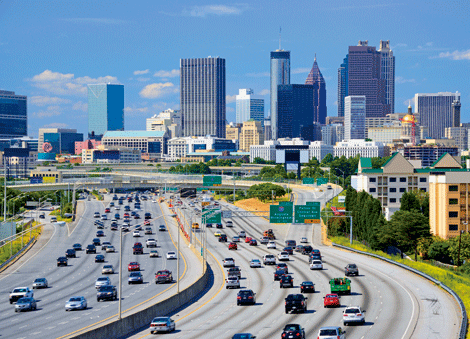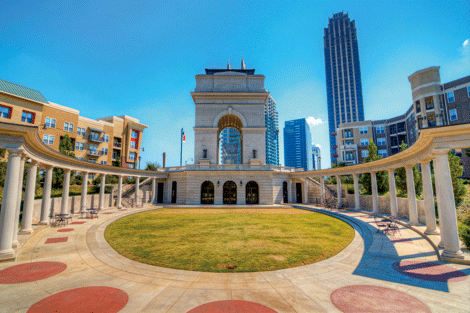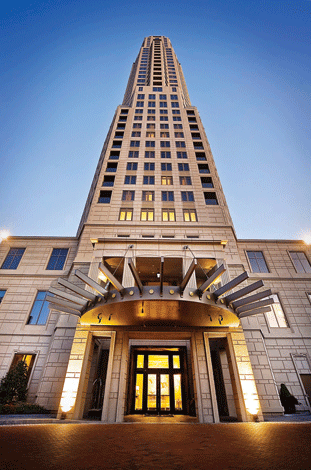Having triumphed through the same era of economic downturn that much of the country faced, the city of Atlanta is once again booming, holding onto its status as the epicentre of the Progressive South. Both business travellers to the city and those who live here are discovering the offerings have risen by an order of magnitude.
For newcomers to the unofficial capital of the South, it will help to get your bearings. The city itself is roughly divided into quadrants, split north-south by the I-75-I85 corridor, and from east to west by I-20. Surrounding all this is The Perimeter, aka I-285, a 103-kilometre-long, eight- to 18-lane-wide river of concrete that encircles Atlanta and connects many of its outlying suburbs. If you’re flying into Atlanta, you’ll want to know that Hartsfield-Jackson International Airport is situated about six o’clock on the circle, wedged into a triangle of land where I-85, I-75 and I-285 criss-cross south of downtown.
With all this woof and warp of interstate highways woven throughout the urban fabric, you might conclude that Atlanta is just a gigantic string of suburbs with a lifeless, even deteriorating downtown core at its centre. And 10 years ago, you might have been right.
“Up until the last decade, Atlanta had been the poster child for suburban sprawl. But the re-urbanisation has really made the in-town experience on par with other great cities,” explains Mark Toro, founder of North American Properties. “Atlanta has become a real city inasmuch as we now offer visitors an urban experience that they were not able to experience before.”
“Thanks to the vision of our most recent mayor, Shirley Franklin, and our current mayor, Kasim Reed, we have been busy laying the foundations for a dramatic transformation of in-town Atlanta, which experienced significant population growth during the past decade, in spite of a national recession,” explains Atlanta City Council member, Kwanza Hall. Hall’s District 2 includes much of Downtown and Midtown Atlanta, where significant change is most evident.
Toro’s company, North American Properties, has launched a joint venture with CBRE, the world’s largest commercial real-estate company, to purchase the relatively new, 138-acre (56 hectare) mixed-use development Atlantic Station from AIG.

“We bought Atlantic Station on New Year's Eve, 2010, and are in the process of repositioning that asset to essentially realise its potential, which is another great example of what’s happening in Atlanta’s in-town communities. In the last 24 months, we’ve signed 24 leases and are bringing in the first three chef-driven, local restaurants, which is what that community seeks,” Hall says proudly. “Atlantic Station is really the only significant concentration of retail and restaurants in all of in-town Atlanta.”
The live, work and play mix at Atlantic Station includes approximately 2,900 residential units and more than 130,000 sqm of class A office space. This is nicely complemented by nearly 50 retail shops and restaurants, and approximately 11 acres (4.5 hectares) of parks for recreation. Now the former steel mill site is the largest urban brownfield redevelopment in the US, an energy-efficient, pedestrian-friendly community that serves as a national model for new urbanism and smart growth.
Taking Care of Business
Metropolitan Atlanta’s 5.5 million inhabitants make up the most populous urban area in Georgia, the third largest in the southeast – behind Washington, DC, and Miami – and the ninth largest in the US.
As with most major metropolitan areas, businesses tend to congregate based on industry sectors.
“Alpharetta is home to 1.5 million sqm of class-A office space that is predominantly occupied by tech sector employers. So it’s Hewlett Packard, Microsoft, ATT and Verizon,” explains Toro. “Buckhead is dominated by financial service firms and law firms. Perimeter is home to larger corporate groups like UPS. And Midtown is becoming the tech sector concentration – not the large corporate tech businesses, but the smaller mid-life start-ups such as Square, Pandora, Nurun and Ogilvy.”
Significant areas of the city are becoming pedestrianised, Toro notes, reflecting a shift away from freeway-centric sprawl. “Because of the concentration of the creative class, people are congregating at walkable businesses,” he says. “That is the bright line differentiation between Atlanta 10 years ago and Atlanta today – the ability to literally walk to work and your chosen place of entertainment, cultural facilities, parks and recreation and mass transit. For many years the knock has been that our transit system is lacking, and it truly is. But in the in-town communities, we’ve got a very strong backbone of transit availability. Perimeter, Buckhead and Midtown all have MARTA (Metropolitan Atlanta Rapid Transit Authority) access that is truly viable today, which is relatively new.”

Millenium Gate triumphal arch at Atlantic station in Midtown
From the Ground Up
For the 95 million-plus passengers who came to and through Atlanta’s Hartsfield-Jackson International Airport in 2012 – ahead of Beijing’s 82 million and Heathrow’s 70 million – the arrival and departure process has become a much smoother operation with the May 2012 opening of the new international concourse.
“We just celebrated our one-year anniversary, “ explains Louis Miller, aviation general manager for ATL. “The additional 12 gates within the new Concourse F, along with the pre-existing gates at Concourse E, brings a total of 40 international gates to Hartsfield-Jackson. This makes us one of the largest in the country and allows a lot of opportunity for future expansion. Up until the addition, when the gates in Concourse E were full, passengers travelling internationally had to fly out of a domestic terminal. Now with enough capacity for international flights, there’s more room to accommodate domestic flights,” says Miller, who oversaw the project.
“We’ve also added a separate new roadway system for the terminal [coming from I-75], 3,700 new parking stalls including a park-n-ride lot, a short-term parking structure and a new cell phone lot. Altogether it’s helped us immensely to keep the traffic moving very efficiently through the international terminal.”
But the one thing that Miller feels is sure to appeal to all passengers travelling internationally through ATL is the new baggage re-check process.
“Prior to the opening of the new terminal, when passengers went through US Customs and Border Protection on Concourse E, it was necessary to re-check your checked luggage. That meant going through security again, then riding the train up to the domestic terminal to pick up your luggage from the baggage claim area. That alone could add 45 minutes to an hour on your clearance time. So it has really been a blessing for us and is working very well.”
Other interior changes passengers will appreciate include an increase in vertical circulation on Concourse D. Scheduled for completion in spring of 2014, the expansion will allow a smoother flow of passengers coming in and out of the concourse; the same plan on tap for Concourse C.
And since 70 per cent of all passengers are making a connection and typically have 60-90 minutes to kill in the airport, popular new interactive directories are further simplifying navigating the airport, to help travellers find amenities that include retail, food and beverage concessions and new premium lounges, including Delta’s new Sky Club on Concourse F. Another option, the Atlanta Chop House restaurant features private meeting rooms for small or large groups. Its location in the Atrium pre-security makes it ideal for meetings with local associates who aren’t travelling.

Georgia aquarium
Down to Earth in Atlanta
According to Mark Demidovich, assistant state traffic engineer with the Georgia Department of Transportation traffic operations, Atlanta’s bad traffic reputation is more bark than bite.
“There are far worse places in the US where one can get stuck in traffic,” Demidovich explains. “Public transportation connects many of the business traveller’s essential transportation nodes, including the airport, Downtown, Midtown and Buckhead.” He points out that while Atlanta has the reputation of being an awful traffic city, it tends not even to make most Top 10 lists of "bad traffic" cities across the US, faring better than smaller places like Austin, TX, and Bridgeport, CT, according to a recent story in USA Today.
Ribbon-cutting ceremonies galore are expected around Centennial Olympic Park, with the opening of two cultural attractions, the College Football Hall of Fame and the National Center for Civil and Human Rights. “Also in 2014, the new Atlanta Streetcar will begin connecting visitors of the attractions around Centennial Olympic Park – including the Georgia Aquarium, CNN, the World of Coca-Cola and the Children’s Museum of Atlanta – to the Martin Luther King Jr Historic Site,” says Councilman Hall.
Concerning the city that has also become a haven for foodies, Toro says, “Eight of the top 10 law firms in Atlanta reside in Midtown. So you see a lot of executives frequenting the restaurants in the five-block radius of Peachtree and 14th Street, which is Main and Main, Atlanta, GA. That’s where the centre of gravity is, if you look at the high-rise residential density, the concentration of cultural and recreational facilities and the concentration of offices and hotels,” he explains. “Loews Hotel is relatively new. You’ve got the Four Seasons, a W Hotel and a number of other hotels serving that market. People who come to Atlanta to do business are eager to take a cab, check in to their hotel, do business and then walk to dinner. You’re seeing a lot of that on Crescent Street. A new seafood restaurant called Lure is one of many in the area, frequented by both business travellers and in-town locals.”
And while Toro’s “Main and Main” is doused with a plethora of great eateries, including STK, he believes the steakhouses in Buckhead still rule the roost with most top-drawer law firms.
“But you’re seeing west Midtown restaurants such as Ford Fry’s concepts, including King + Duke, now in Buckhead. Fry has two other concepts in Midtown, including JCT Kitchen and The Optimist, which was voted number-one new restaurant in the US by Esquire
(www.theoptimistrestaurant.com). Business travellers are seeking a local restaurant experience that’s not the clubby steakhouse. They’re seeking to find that young, new hot chef with a concept that’s resonating with the in-town community,” Toro concludes.
And when it comes to sushi, Buckhead’s Czar Ice Bar boasts one of a handful of the world’s master sushi chefs – Chef Saito Saito, as the genius of the famous Japanese delicacy. Visit www.czaricebar.com.
Finally, do not depart Atlanta before grabbing a Sublime Burger from Cypress Street Pint and Plate in Midtown. Featured on food shows and networks galore, this decadent burger of beef, topped with cheddar cheese, caramelised onions and strips of bacon sandwiched between two glazed doughnuts, is made exclusively by Atlanta’s premier doughnut shop – Sublime Doughnuts. Visit www.cypressbar.com

Mandarin Oriental Atlanta
ThE HOTEL SCENE
Atlanta is awash with hotel renovations, and even the occasional new property making its debut.
Starwood’s Aloft brand will open a property in January. The 242-room hotel is situated on 1.25 hectares, and delivers 185 sqm of meeting space and an outdoor swimming pool to contend with the Georgia summer heat.
The US$45 million overhaul of the iconic Westin Peachtree Plaza includes redesigned guestrooms – five of which are new additions – for a grand total of 1,073. It also includes a US$2 million revamp to the six luxury suites located on the 69th and 70th floors. Completion is set for 2014.
The Hyatt Regency Atlanta finished a sweeping US$65 million overhaul in 2012, with the welcome addition of meeting breakout rooms and a dramatic conversion of the former restaurant into a 241 sqm pre-function space.
The Midtown Meliá Atlanta has undergone a US$35 million renovation that showcases updated guestrooms, restaurants and common areas. The 372-room Westin Atlanta Perimeter North has US$14 million in upgrades on track to be completed in six months. Elsewhere on the Perimeter, the old 275-room Atlanta Perimeter Hotel & Suites is now flying the flag of the Parisian-inspired Le Méridien after emerging from a US$20 million makeover. And Marriott Alpharetta is winding up its US$3 million, multi-stage renovations which are slated for completion later this year.
Meanwhile, in the upscale Buckhead neighbourhood, May 1 marked the opening of a new world-class hotel in Atlanta, the Mandarin Oriental.
“As the hotel is located in the heart of Buckhead, considered the city’s most prestigious neighbourhood, we are able to provide our guests with easy access to the region’s finest dining, shopping and cultural attractions,” says Robert Lowe, general manager. The 127-room, 10-suite property features two executive boardrooms, an English garden for alfresco events, and a 1,393 sqm spa.
For more details visit www.atlanta.com








